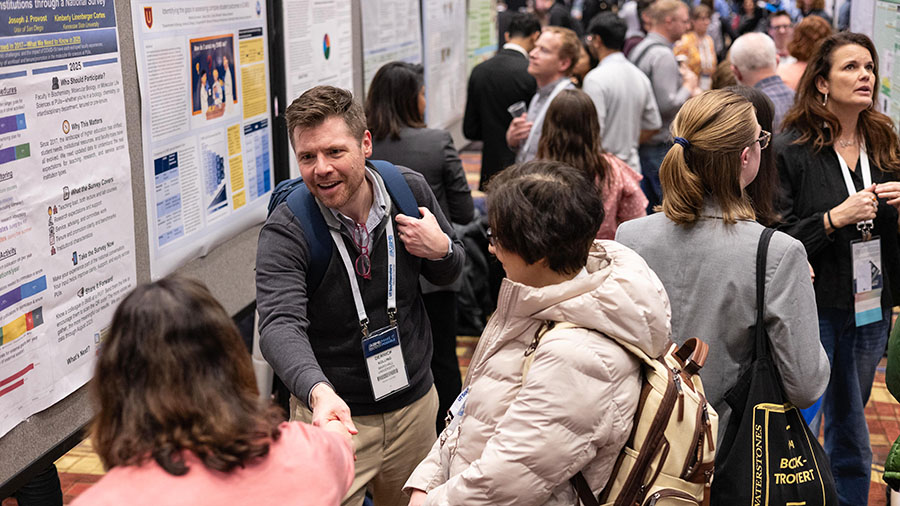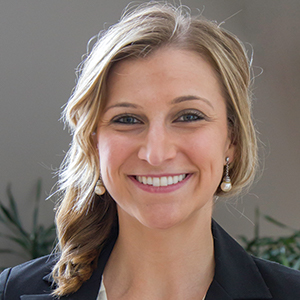Peer through a window to the future of science
This March, the American Society for Biochemistry and Molecular Biology annual meeting heads to the Gaylord National Harbor Resort and Convention Center, just outside Washington, D.C. By bringing together scientists with diverse backgrounds and experiences, the meeting aims to inspire new ideas and drive progress in molecular life sciences.
Co-chairs Sandra Gabelli, the global head of protein and structural chemistry at Merck, and Aaron Hoskins, a professor of biochemistry and chemistry at the University of Wisconsin–Madison, bring expertise from both industry and academia, spanning structural biology, drug discovery, RNA processing and single-molecule biophysics.
Gabelli and Hoskins spoke with ASBMB Today to share what’s new in science, fresh in format and why the 2026 ASBMB annual meeting will offer more ways for scientists to make meaningful connections across sectors and disciplines.
What is unique about the ASBMB annual meeting, especially for 2026?
Hoskins:It's a window into the entire field of biochemistry and molecular biology. Whether you’re into nucleic acids, metabolism or artificial intelligence, you’ll find something exciting. That breadth is what makes this meeting special.
This year’s meeting features significantly more speakers and organizers from biotech and industry, nearly 25%, marking a major shift from previous years.
Gabelli: I’d add that this meeting is about building community. I started attending ASBMB as a grad student. It’s not just about data — it's about shared experiences, mentorship and career journeys.
Share an inspiring ASBMB meeting memory.
Hoskins:I remember one year when ASBMB was held jointly with the Experimental Biology meeting, one of my undergraduate students presented a poster while his mother, a nutritionist attending with another society, was there to watch. Seeing him explain his research to her, and how proud she was, was a truly joyful moment.
Gabelli: In the late 1990s, I attended an ASBMB annual meeting as a graduate student focused on solving protein structures with X-ray crystallography, often disconnected from functional studies. During one session, a speaker presented enzymatic data that perfectly complemented structural insights, showing how subtle changes in kinetics aligned with specific conformational shifts. That talk was a turning point; it opened my eyes to the power of integrating biochemical assays with structural data. I began incorporating enzymology into my research, which sparked a lasting shift toward an interdisciplinary mindset, connecting structure to function and static data to dynamic, biological understanding.

What keeps you coming back to ASBMB annual meetings?
Hoskins: The science and the people. The poster sessions are always a highlight. I advise the ASBMB undergrad chapter at my institution, and this meeting is the biggest event of the year for our students.
Gabelli: I keep coming back for the science and the community. While I was at Johns Hopkins, my lab benefited enormously from these meetings. Now in industry, I still find inspiration and fresh ideas — from new techniques to powerful conversations with peers.
Tell me about this year’s meeting themes.
Hoskins: Each day kicks off with a 'deep dive' session — one big topic, a keynote speaker and two breakout tracks. It’s a focused way to start the day and sets the tone for broader exploration that follows in the afternoon.
This year’s deep dive topics are aging, AI/robotics and biological/molecular communication. These aren’t just trendy; they’re relevant to researchers across disciplines and nonscientists as well.
Who should attend this meeting?
Gabelli: The ASBMB meeting is for everyone in the molecular life sciences — academic researchers, educators, industry scientists from startups to big pharma and those working in government, regulation or patent law. It’s a chance to learn new, applicable methods you can bring back to your own lab while making meaningful connections across sectors. That mix of practical insight and community-building is what makes this meeting so valuable.
Hoskins: Anyone interested in biochemistry or molecular biology should attend, no matter what your career stage or path. Early-career scientists can meet potential mentors and future collaborators, while seasoned researchers can explore new directions or sharpen how they teach and communicate science. It’s a rare opportunity to immerse yourself in cutting-edge research and join conversations that move the field forward
How can attendees contribute to the program?
Gabelli: One of the best ways to contribute is by submitting an abstract; many talks and posters will come directly from attendee submissions. You can also get involved through mini-symposia and workshops. These member-driven sessions let you organize a session and shape the meeting program. It’s a true grassroots effort that puts emerging science and fresh perspectives at the center of the conference.
What advice do you have for attendees?
Hoskins: Attendees should take full advantage of the ASBMB meeting app — it’s a great tool for planning your schedule so you don’t miss the sessions and posters you’re most excited about.
We’re also introducing 'Speakers’ Choice' stickers at the poster sessions. Invited speakers will tag standout posters, making it easy for attendees to spot must-see research as they explore the hall.
What are you most excited about for the 2026 D.C. location?
Hoskins: D.C. is an incredible host city, with world-class museums and cultural sites, most of them free. On the scientific side, it’s a unique opportunity to engage with researchers who might not typically attend the ASBMB annual meeting, including those at the National Institutes of Health, National Science Foundation and others working in science policy, law and government. We’re excited to draw in new voices and share the latest in biochemistry and molecular biology.
Gabelli: The D.C.–Baltimore region is rich with active research universities and a strong ASBMB presence. It’s an ideal setting to connect across academia, industry and policy: sectors that shape the future of biomedical science. I lived there for 30 years, and I’m thrilled to return and experience everything the area has to offer.
About the organizers

Sandra Gabelli is the global head of protein and structural chemistry at Merck. She leads a team that uses structural biology to answer key biochemical questions: how targets are engaged, how mechanisms of action work, and how ligands interact with targets for drug discovery design. Her group expresses, purifies proteins and applies biochemical and biophysical techniques to reveal detailed molecular insights, including visualizing how drugs bind to their targets and the effect of drugs in tissue.

Aaron Hoskins is a professor of biochemistry and chemistry at the University of Wisconsin–Madison. His group studies eukaryotic RNA processing and single-molecule biophysics. They explore macromolecular machine assembly, regulation and interactions with other molecules such as proteins and nucleic acids.
Enjoy reading ASBMB Today?
Become a member to receive the print edition four times a year and the digital edition monthly.
Learn moreFeatured jobs
from the ASBMB career center
Get the latest from ASBMB Today
Enter your email address, and we’ll send you a weekly email with recent articles, interviews and more.
Latest in Careers
Careers highlights or most popular articles

Exploring the link between lipids and longevity
Meng Wang will present her work on metabolism and aging at the ASBMB Annual Meeting, March 7-10, just outside of Washington, D.C.

Upcoming opportunities
Calling all biochemistry and molecular biology educators! Share your teaching experiences and insights in ASBMB Today’s essay series. Submit your essay or pitch by Jan. 15, 2026.

Defining a ‘crucial gatekeeper’ of lipid metabolism
George Carman receives the Herbert Tabor Research Award at the ASBMB Annual Meeting, March 7–10, just outside of Washington, D.C.

Building the blueprint to block HIV
Wesley Sundquist will present his work on the HIV capsid and revolutionary drug, Lenacapavir, at the ASBMB Annual Meeting, March 7–10, in Maryland.

Upcoming opportunities
Present your research alongside other outstanding scientists. The #ASBMB26 late-breaking abstract deadline is Jan. 15.

Designing life’s building blocks with AI
Tanja Kortemme, a professor at the University of California, San Francisco, will discuss her research using computational biology to engineer proteins at the 2026 ASBMB Annual Meeting.

